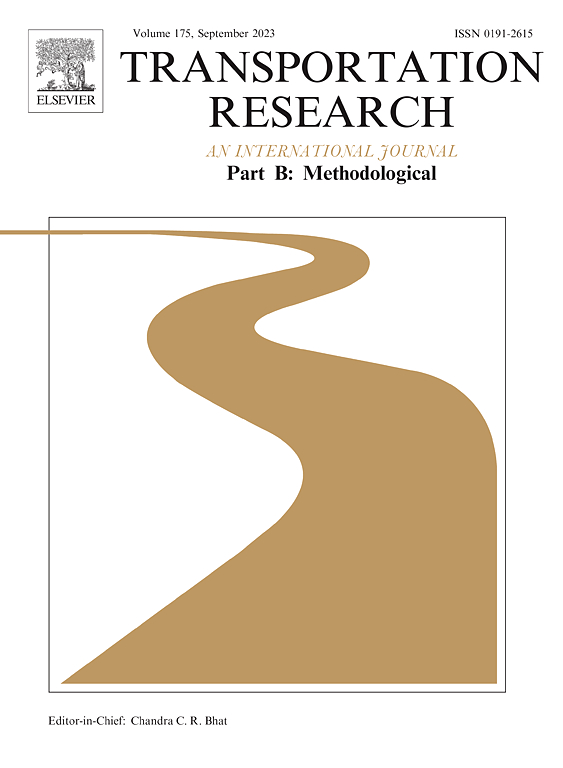Estimating gap acceptance parameters with a Bayesian approach
IF 5.8
1区 工程技术
Q1 ECONOMICS
引用次数: 0
Abstract
The gap acceptance framework is the theoretical basis for modelling traffic flow at intersections with a priority control. Reliable estimation methods for key gap acceptance parameters are important to more accurately predict key traffic performance measures such as capacity and delay. A notable challenge is that the critical gaps are not directly observable. Currently, the maximum likelihood estimator (MLE) is widely accepted as the most reliable method. In this research, we considered a Bayesian approach as an alternative framework for estimating gap acceptance parameters, which achieves a comparable performance to the MLE. We first formalised the gap acceptance statistical model and the estimand of interest, based on a Bayesian hierarchical formulation that naturally captures the variations between drivers. We then tested the performance of each method on simulated dataset, with the Bayesian posterior obtained through the No-U-Turn sampler, an adaptive Markov chain Monte Carlo algorithm. We showed that the MLE and the posterior mean as a point summary of the full posterior distribution have comparable performance, and both generally achieve a mean absolute error s for different major stream flow in our experiment setup. In addition, we found that the standard error is higher for both low and high so any point estimator is unlikely to be equally reliable across all level of ’s. Furthermore, we also identified a potential issue when assuming consistent drivers and log-normally distributed critical gaps at high , as the heavy tail of the log-normal can result in unrealistic dataset. The full Bayesian approach also allows inherent uncertainty quantification, which we found to be well-calibrated, in the sense that the credible intervals obtained have roughly the correct frequentist coverage as per confidence intervals constructed with frequentist methods. From a traffic engineering point of view, quantifying uncertainties in gap acceptance parameters, whether using Bayesian or frequentist methods, is important as they induce uncertainties on intersection performance metrics such as capacity and delay, which will allow more informed decision-making for infrastructure investment. In addition, we also assessed the performance of Bayesian methods for more complicated statistical models, using a test scenario involving inconsistent driver behaviour, by jointly estimating the gap acceptance parameters and the inconsistency parameters. Lastly, we demonstrated the applicability of the proposed Bayesian framework to real data collected at roundabouts in Perth, Western Australia. We found the mean critical gap to mostly lie between 3.0 to 5.0 s, and the standard deviation between 1.0 to 2.0 s, and our validation checks suggest the potential need to extend the statistical model with consideration of the interactive nature of roundabouts.
用贝叶斯方法估计间隙接受参数
间隙接受框架是建立具有优先控制的交叉口交通流模型的理论基础。关键间隙接受参数的可靠估计方法对于更准确地预测关键交通性能指标(如容量和延迟)至关重要。一个值得注意的挑战是,关键的差距是无法直接观察到的。目前,极大似然估计(MLE)被广泛认为是最可靠的方法。在这项研究中,我们考虑了贝叶斯方法作为估计间隙接受参数的替代框架,它达到了与MLE相当的性能。我们首先将差距接受统计模型和兴趣估计形式化,基于贝叶斯层次公式,该公式自然地捕获了驱动程序之间的差异。然后,我们在模拟数据集上测试了每种方法的性能,并通过自适应马尔可夫链蒙特卡罗算法No-U-Turn采样器获得贝叶斯后验。我们发现,MLE和后验均值作为全后验分布的点总结具有相当的性能,在我们的实验设置中,对于不同的主流流量qp,两者的平均绝对误差一般都≤0.2 s。此外,我们发现低qp和高qp的标准误差都更高,因此任何点估计器在所有qp水平上都不可能同样可靠。此外,我们还发现了一个潜在的问题,即在高qp下假设一致的驱动因素和对数正态分布的临界间隙,因为对数正态分布的重尾可能导致不现实的数据集。完整的贝叶斯方法也允许固有的不确定性量化,我们发现这是很好的校准,从某种意义上说,所获得的可信区间与用频率方法构建的置信区间大致具有正确的频率覆盖。从交通工程的角度来看,无论是使用贝叶斯方法还是频率方法,量化缺口接受参数中的不确定性都很重要,因为它们会引起交叉口性能指标(如容量和延迟)的不确定性,这将为基础设施投资提供更明智的决策。此外,我们还使用涉及不一致驾驶员行为的测试场景,通过联合估计间隙接受参数和不一致参数,评估了贝叶斯方法在更复杂统计模型中的性能。最后,我们证明了所提出的贝叶斯框架在西澳大利亚珀斯环形交叉路口收集的真实数据的适用性。我们发现,平均临界差距大多在3.0到5.0秒之间,标准差在1.0到2.0秒之间,我们的验证检查表明,考虑到环形交叉路口的交互性质,可能需要扩展统计模型。
本文章由计算机程序翻译,如有差异,请以英文原文为准。
求助全文
约1分钟内获得全文
求助全文
来源期刊
CiteScore
12.40
自引率
8.80%
发文量
143
审稿时长
14.1 weeks
期刊介绍:
Transportation Research: Part B publishes papers on all methodological aspects of the subject, particularly those that require mathematical analysis. The general theme of the journal is the development and solution of problems that are adequately motivated to deal with important aspects of the design and/or analysis of transportation systems. Areas covered include: traffic flow; design and analysis of transportation networks; control and scheduling; optimization; queuing theory; logistics; supply chains; development and application of statistical, econometric and mathematical models to address transportation problems; cost models; pricing and/or investment; traveler or shipper behavior; cost-benefit methodologies.

 求助内容:
求助内容: 应助结果提醒方式:
应助结果提醒方式:


